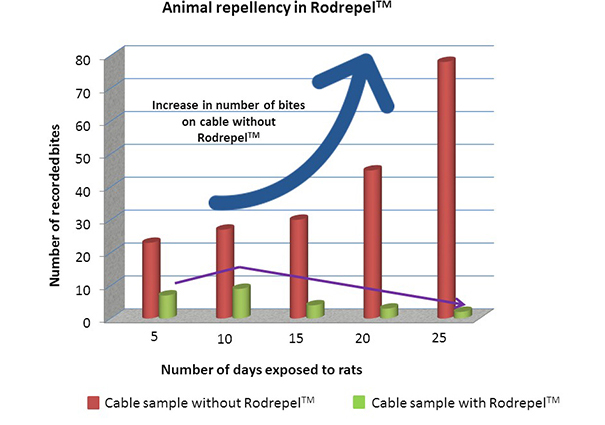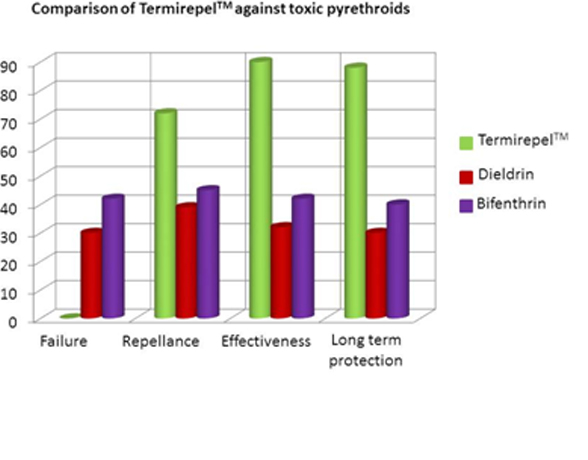Besides this, CombirepelTM has extra properties to repel off a much wider species of birds and hence it is an effective animal, insect, and bird aversive repellent.
RodrepelTM and TermirepelTM have been extensively tested both in house as well as by reputed government testing institutes such as The Haffkine Institute of Training, Testing and Research, Bombay; the Indian Institute of Chemical Technology, Hyderabad and so on in various applications such as cables, pipes at various loadings for their efficacy and have been found to be successfully evaluated effective anti-rodent and anti-termite products.
Laboratory tests conducted with cables containing RodrepelTM have demonstrated that cables bitten by rats produce a very foul reaction in the animal, without harming it in any way. In almost all cases, the animal did not bite into the cable again. These tests were carried across a period of time. The graph in the figure below indicates that the number of rodent bites goes on decreasing as days pass with RodrepelTM extruded cables while an exactly opposite trend is observed in cables without RodrepelTM. Moreover, RodrepelTM has proved to be effective against a wide variety of animals ranging from rats, mice, squirrels, wild boar, to woodpeckers and even to grizzly bears.


The below graph is a comparison between the toxic pyrethroids like dieldrin and bifenthrin and our safe product TermirepelTM in terms of failure, repellence, effectiveness, and long term protection. It can be concluded that TermirepelTM is safe and effective when compared to these toxic pyrethroids.

CombirepelTM is available in the form of concentrate based on LDPE as well as EVA polymeric granules. It is also available as:
As CombirepelTM is effective at parts per million levels; it does not interfere with the physical or chemical properties of polymers or compounded polymers. It is designed to withstand the extreme heat of polymer processing as also enhanced and uniform dispersion along the length of the polymer matrix. Since our products are used at low loadings, the physical properties of the polymers or the compounding process are not at all affected.
CombirepelTM has been incorporated as an aerosol spray, used as a gel to protect from woodpeckers and other birds, used on roofs. CombirepelTM has been very successfully added to wires and cables, utility pipes, silage films, seats, etc.
Since CombirepelTM is designed to repel pests effectively and not kill the rodents/termites or any other animal/insect; it doesn't harm any target or non-target species in any way. We are committed to our environment & we believe that no harm must be caused to animals or to the environment. Cables & pipes often pass through large expanses of untouched forests & outdoors, several native & protected species often come into contact with these cables. Moreover, crops often get damaged due to indeterminate and arbitrary use of pesticides and insecticides. These can even affect target species which are in fact useful for agriculture such as bees which help in pollination, earthworms which help in maintaining the porosity of the soil which is extremely important for crops.
Moreover, even termites although they cause a lot of damage are in fact necessary in maintaining the ecological balance. Ecologically, termites are important in nutrient recycling, habitat creation, soil formation and quality and, particularly the winged reproductives, as food for countless predators. The role of termites in hollowing timbers and thus providing shelter and increased wood surface areas for other creatures is critical for the survival of a large number of timber-inhabiting species. Larger termite mounds play a role in providing a habitat for plants and animals, especially on plains in Africa that are seasonally inundated by a rainy season, providing a retreat above the water for smaller animals and birds, and a growing medium for woody shrubs with root systems that cannot withstand inundation for several weeks. Thus CombirepelTM is designed to be a completely harmless product.
It is safe for humans as well. Therefore any sort of accidental ingestion wouldn't prove to be fatal or have any detrimental side effects but merely unpleasant.
CombirepelTM is completely inert within the polymer matrix apart from executing its primary function of repelling the animal/insect. Thus it doesn't leach out to pollute and as a result wouldn't contaminate the groundwater, surface water reserves, and soil. Moreover, it has a low vapor pressure which means that it doesn't volatilize easily thus not resulting in vapors mixing with the atmosphere. Also, it is thermally stable at the highest polymeric processing temperatures.
CombirepelTM has been designed considering the unique requirements of the myriad applications.
Most of the polymeric applications require processing additives at elevated temperatures through the process of extrusion. Thus, thermal stability is a prime consideration for most additives to be used. CombirepelTM molecules are stable and thus can withstand almost all polymeric processing temperatures.
Extrusion temperatures being as high as 100-300°C, CombirepelTM can be used effectively for processing in polymers while at the same time retaining its efficiency.
Most often toxicologists use Lethal Dose and Lethal Concentration to gauge the toxicity of most chemicals; evaluated on many kinds of animals but most often testing is done with rats and mice. The LD50 or LC50 is one way to measure the short-term poisoning potential (acute toxicity) of a material.
It is usually expressed as the amount of chemical administered (e.g., milligrams) per 100 grams (for smaller animals) or per kilogram (for bigger test subjects) of the body weight of the test animal. The LD50 can be found for any route of entry or administration but dermal (applied to the skin) and oral (given by mouth) administration methods are the most common.
| Gosselin, Smith and Hodge Scale | ||
|---|---|---|
| Probable Oral Lethal Dose (Human) | ||
| Toxicity Rating or Class | Dose | For 70-kg Person (150 lbs) |
| 6 Super Toxic | Less than 5 mg/kg | 1 grain (a taste - less than 7 drops) |
| 5 Extremely Toxic | 5-50 mg/kg | 4 ml (between 7 drops and 1 tsp) |
| 4 Very Toxic | 50-500 mg/kg | 30 ml (between 1 tsp and 1 fl ounce) |
| 3 Moderately Toxic | 0.5-5 g/kg | 30-600 ml (between 1 floz and 1 pint) |
| 2 Slightly Toxic | 5-15 g/kg | 600-1200 ml (between 1 pint to 1 quart) |
| 1 Practically Non-Toxic | Above 15 g/kg | More than 1200 ml (more than 1 quart) |
All grades of CombirepelTM fall under category 1 i.e. "Practically non-toxic". CombirepelTM has been classified under FIFRA (Section 25 B) as a minimum risk pesticide.